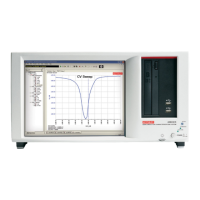4200-900-01 Rev. K / February 2017 Return to Section Topics 3-125
Model 4200-SCS User’s Manual Section 3: Common Device Characterization Tests
program and erase state dependencies on pulse parameters. There are three
different waveform types available:
• Program Erase
• Fast Program
•Erase
The Program waveform and Erase waveform output pulses with a single set of
parameters for the pulse width, transition (0 to 100 % rise/fall), and level (see
Figure 3-102).
The Fast Program and Erase test waveform uses two pulses that can have
independent widths and levels (see Figure 3-103).
Each test permits programming the pulse width, level and transition (0 to 100 %
rise/fall) parameters, as well as the number of pulses.
For extended Program Erase cycling, use one of the FlashEndurance projects.
Instead of a voltage the disconnected or open state may also be chosen for any
pulse segment. The open state is useful when tunneling for programming or
erasing a floating gate transistor.
These projects support from one to eight pulse channels to support typical
4-terminal devices and higher pin count devices or array test structures.
NOTE The 8-terminal testing requires four Model 4205-PG2 cards and, for most tests, a
compatible external switch matrix.
The purpose of these projects is to initially characterize a floating gate transistor.
For example, determine the appropriate pulse parameters for both the program
and erase waveforms to reach a target V
TE
and V
TP
.
This can be done by setting the Program pulse height to the desired value, but
setting the pulse width to a fraction of the expected pulse width (Entering
Segment ARB values into UTM array parameters).
1. Set the NumPulses to one and uncheck the Erase and Fast-Program-Erase tests.
2. Run the Program, SetupDC and Vt-MaxGm tests, monitoring the shift in the V
T and noting
the number of pulses required to reach the target Vt
TP
.
Then the same approach can be used for the erase. If the DUT was initially in an
unknown state, the determination of appropriate pulse parameters for the program
and erase waveforms may be iterative.
The Fast-Program-Erase test may be used to confirm that the chosen pulse
parameters are providing an acceptable erase, and the VT after the Fast-Program-
Erase is not shifting.
Once acceptable pulse parameters are determined, use Kpulse to define and
export the waveforms for use in the Endurance and Disturb projects (see Using
Kpulse to create and export Segment ARB waveforms).

